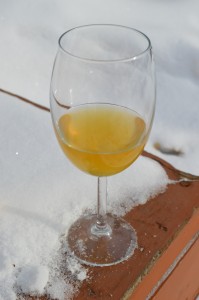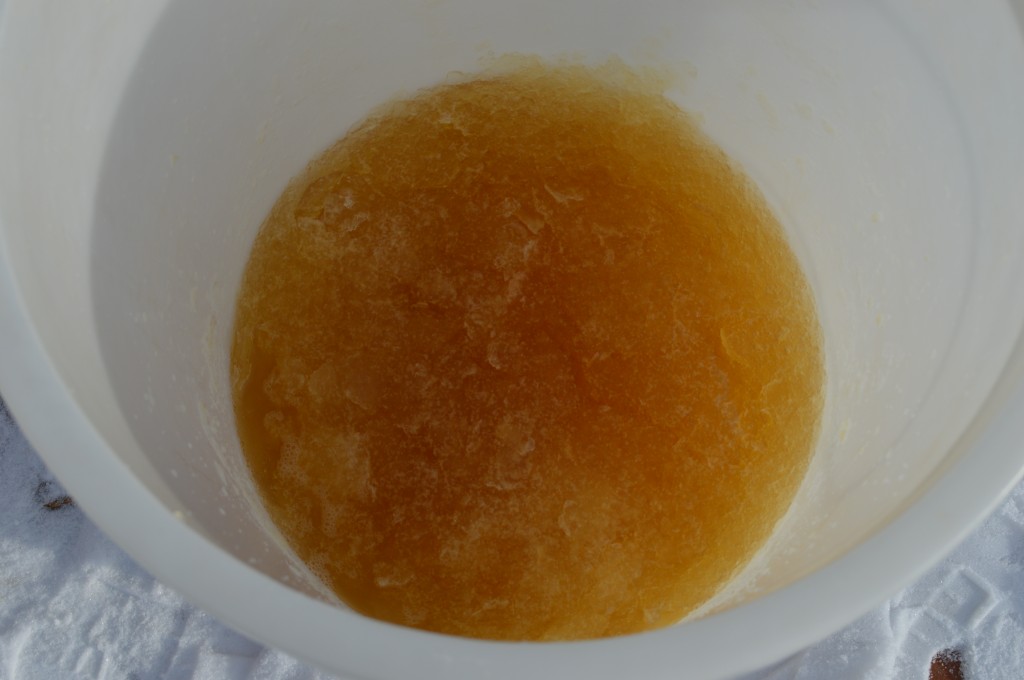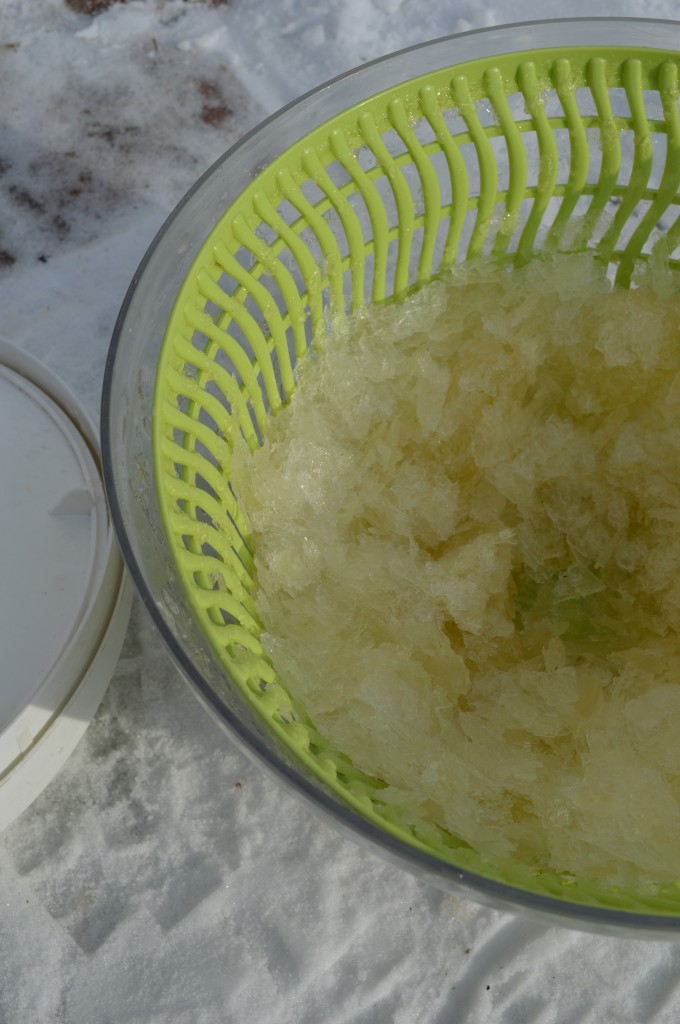 While reading the maple syrup section of On Food and Cooking, I came across a shocking bit of information.
While reading the maple syrup section of On Food and Cooking, I came across a shocking bit of information.
Even though North American Indians didn’t have metal pots until the Europeans came, they had an ingenious method for reducing maple sap to make syrup. They would leave the sap in the cold air overnight. In the morning there would be ice on top. That ice would be mostly (but not exclusively) water, so in discarding the ice they were left with a higher concentration of sugar in the sap.
After reading this, I immediately turned to the section of the book on distilled spirits, to see if there was any mention of whether this method works to concentrate alcoholic solutions. Sure enough, there was a boxed sidenote titled, “Concentration by Freezing,” with references to all kinds of liquors that are made in the frosty outdoors and never see the inside of a still.
On the internet, notably Wikipedia, this process goes by the name “freeze distillation.” My dad, a process engineer, takes exception to the term, as distillation separates solutes based on their different boiling points. There is a process called freeze crystallization that separates solutes based on their different freezing points, but that doesn’t apply here, either. The large difference between the freezing points of water (0°C) and ethanol (-114°C) is not what makes this process work, as evidenced by the fact that the process can concentrate maple syrup, which has no ethanol. I’m going to use the accurate though somewhat anemic word “concentration.”
Process
Put your drink in a bowl and put it in a freezing environment like, say, your freezer. Or maybe your backyard.
When I first read about freeze-concentration, I imagined that there would be a clear, easily separated layer of pure ice on top, and a liquor beneath. This is not what happens. Instead you end up with a strange, delicate-but-solid crystalline block.
If you turn this block of ice into another container, you can easily mash it up into a slushy mixture.
 Next you can strain the liquid off the ice crystals.
Next you can strain the liquid off the ice crystals.
 And to maximize extract, you can transfer the remaining ice to a salad spinner to squeeze out a bit more applejack.
And to maximize extract, you can transfer the remaining ice to a salad spinner to squeeze out a bit more applejack.
Results
I started with 10 L of cider, and finished with between 2.25 and 2.50 L of applejack for a volume yield of about 23%.
- Appearance -The applejack is slightly darker than the cider, with a bronze hue compared to the cider’s gold (image below).
- Nose –
- Taste – The difference in taste is pretty substantial. Sharply acidic, with warming alcohol.
- Mouthfeel – The applejack had a subtly richer mouthfeel. I was using still cider, but note that if you use bubbly stuff the apple jack will not be carbonated…

I also tried this concentration method with beer. I had never heard of beer being freeze-concentrated, but I thought I should try it, since the AGLC has banned strong beer from stores. [Editor’s Note: There is a classic German beer that is freeze-concentrated: it’s called an Eisbock.] I used Big Rock Traditional Ale, which is based on (ahem) traditional English ales. It has a dark caramel colour with a hint of red, and is very clear. It has a slightly fruity nose and tastes of caramel and roasted malt. It’s one of my favourite Albertan beers.
I froze 700 g of beer and pressed 215 g of liquor from the ice, meaning roughly two thirds of the beer was wasted.
- Appearance -The liquor was ever so slightly darker than the original beer.
- Taste – The difference in taste was noticeable, but subtle. The sweetness and the roasted, caramel notes were definitely enhanced, though it didn’t taste any more boozy than the original.
- Mouthfeel – The beer lost its carbonation.
- Overall assessment – The results were pleasing, but not nearly good enough to justify wasting two thirds of a beer.
Future Experiments
In terms of percent of alcohol captured from the original drink, freeze-concentrating is not as effective as distillation, but it definitely has its advantages. It preserves the flavour of the original drink much, much better than distillation, which doesn’t capture any sugars or acidity.
Freeze-concentrating also has advantages over heat-concentrating (ie. reducing over heat). Aggressive concentration by heat introduces dark caramel flavours to the liquid. If you had a chance to taste Indian Head birch syrup when the River Valley Syrup Company was selling at the Old Strathcona market, you know that it is a lot darker in colour and taste than most maple syrup. I think this was because birch sap has a lower sugar concentration than maple, and was therefore reduced more in order to produce a comparably sweet product. The prolonged reduction resulted in lots of deeply caramelized sugars. That darkness of flavour was certainly one of the appeals of the product, but it would be interesting to try freeze-concentrating sap.


The term I have in my head from my research last winter is 'fractional distillation by freezing'. I was researching apple ciders and wines, and of course came across applejack. Brilliance. The concentration of flavor and sugar vastly defeats distillation in concept from a flavor standpoint.
I learned about this from a You Tube site during my adventures while non weightbearing for eight weeks. I tried it with my expired juice wine that no one thought was good to start with. (To me it tastes like sherry which I don't particularly like.)The method recommended on this site was to pour slushed wine into salad spinner with a cheese cloth and spin out the alchohol. The ice remains behind and you are left with the concentrated alchohol. I repeated this a few times as my fridge freezer doesn't get very cold and the weather was nicer then. It definitely reduced the volume. I sampled but is didn't seem very alcholic.
I think it is cool as a concept for reducing maple syrup though. I wonder if any of the birch trees on the acreage are big enough to tap.
Read my post about Scotch Tasting at Christmas in November – the fellow said the fatty acids in the liquor stick to the ice and are lost on it when ice is added to scotch. Would this translate to beer or wine, too? This "concentration" might only work with foods – not alcohols??? though the cold distillation could work with the alcohol??? And, isn't the contracting of the molecular make up of the product concentrating the flavour? Just asking.
Yet – Momofuku has a foie gras au torchin – well no au torchin… but a shaved ice foie that involves freezing the foie to concentrate its flavour.
HMMM….
Hello it is December 11th – where is my advent calendar?
:)
I believe some caution should be used. In my research on concentrating by freezing alcoholic beverages, there were some sources stated this process may increase concentrations of undesirable chemicals naturally present in the drink but at low concentrations (unlike distillation which tends to concentrate only the ethanol). Apparently freeze concentrating can increase the the proportion of other chemical to a more toxic level. I believe methanol was one of the concerns but there may be others.
Hello Anonymous. That makes perfect sense.
Since I got about a 30% yield with both attempts, I am concentrating ethanol (and some other components) by at most 3 times. Hopefully that's not enough to do any harm, even if the component is toxic.
I'll have to read into it more. Thanks for the info.